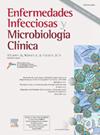随访血培养在老年患者大肠杆菌和肺炎克雷伯菌血症中的作用
IF 2.5
4区 医学
Q3 INFECTIOUS DISEASES
Enfermedades infecciosas y microbiologia clinica
Pub Date : 2025-08-01
DOI:10.1016/j.eimc.2024.12.011
引用次数: 0
摘要
我们的目的是研究获得随访血培养(FUBC)和持续培养FUBC对老年年龄组大肠杆菌和肺炎克雷伯菌引起的菌血症病例临床结局的影响。方法65岁以上的大肠杆菌或肺炎克雷伯菌血症患者纳入研究。患者分为获得FUBC的患者和未获得FUBC的患者。FUBC患者分为持续性菌血症组和阴性FUBC组。比较两组间的人口学、临床特征和结果。结果共纳入142例患者。79例(55.6%)患者检出FUBC, 23例(29.1%)患者检出持续性菌血症。有和没有FUBC的患者在人口学数据和临床特征上没有显著差异。有无FUBC患者的预后无统计学差异。持续性菌血症患者糖尿病患病率较高,指数血培养与FUBC之间的间隔较短(2.9天对4.2天)。在住院时间、重症监护病房需求、插管、血管加压治疗和14、30、90天全因死亡率方面,持续菌血症患者与未在FUBC上生长的患者之间没有差异。在65岁以上的大肠杆菌或肺炎克雷伯菌血症患者中,无论是获得FUBC还是在FUBC上持续菌血症,在死亡率和需要入住重症监护病房等结局方面都没有任何差异。本文章由计算机程序翻译,如有差异,请以英文原文为准。
The role of follow-up blood cultures in Escherichia coli and Klebsiella pneumoniae bacteremia in geriatric patients
Introduction
We aimed to investigate the effect of obtaining follow-up blood cultures (FUBC) and persistent growth in FUBC on clinical outcomes in bacteremia cases caused by Escherichia coli and Klebsiella pneumoniae in the geriatric age group.
Methods
Patients over 65 years of age with E. coli or K. pneumoniae bacteremia were included in the study. Patients were grouped as those who obtained FUBC and those who did not. Patients with FUBC were grouped as persistent bacteremia or negative FUBC. Demographic, clinical characteristics and outcomes were compared between these groups.
Results
A total of 142 patients were included. FUBC were obtained in 79 patients (55.6%) and persistent bacteremia was detected in 23 (29.1%). There were no significant differences in demographic data and clinical characteristics between patients with and without FUBC. There was no statistical difference in the outcomes between patients with of without FUBC. Patients with persistent bacteremia had a higher prevalence of diabetes mellitus, and the interval between index blood culture and FUBC was shorter (2.9 days versus 4.2 days). There was no difference between patients with persistent bacteremia and patients with no growth on FUBC in terms of length of hospital stay, need for intensive care unit, intubation, vasopressor therapy, and 14, 30, 90-day all-cause mortality.
Conclusion
In patients over 65 years of age with E. coli or K. pneumoniae bacteremia, neither obtaining FUBC nor persistent bacteremia on FUBC showed any difference in terms of outcomes such as mortality and need for admission to an intensive care unit.
求助全文
通过发布文献求助,成功后即可免费获取论文全文。
去求助
来源期刊
CiteScore
2.10
自引率
8.00%
发文量
194
审稿时长
29 days
期刊介绍:
Hoy está universalmente reconocida la renovada y creciente importancia de la patología infecciosa: aparición de nuevos agentes patógenos, de cepas resistentes, de procesos con expresión clínica hasta ahora desconocida, de cuadros de una gran complejidad. Paralelamente, la Microbiología y la Infectología Clínicas han experimentado un gran desarrollo como respuesta al reto planteado por la actual patología infecciosa. Enfermedades Infecciosas y Microbiología Clínica es la Publicación Oficial de la Sociedad Española SEIMC. Cumple con la garantía científica de esta Sociedad, la doble función de difundir trabajos de investigación, tanto clínicos como microbiológicos, referidos a la patología infecciosa, y contribuye a la formación continuada de los interesados en aquella patología mediante artículos orientados a ese fin y elaborados por autores de la mayor calificación invitados por la revista.

 求助内容:
求助内容: 应助结果提醒方式:
应助结果提醒方式:


